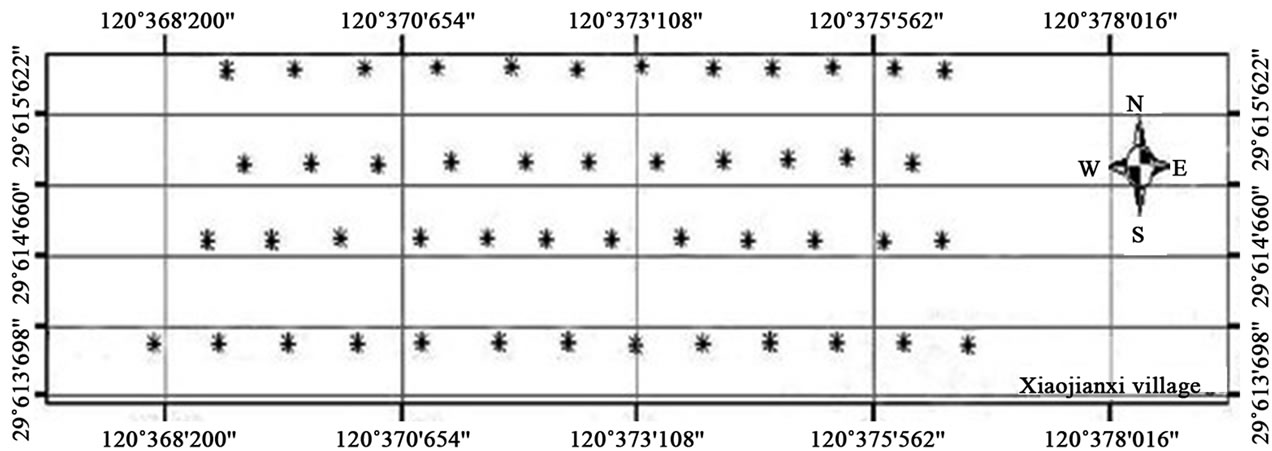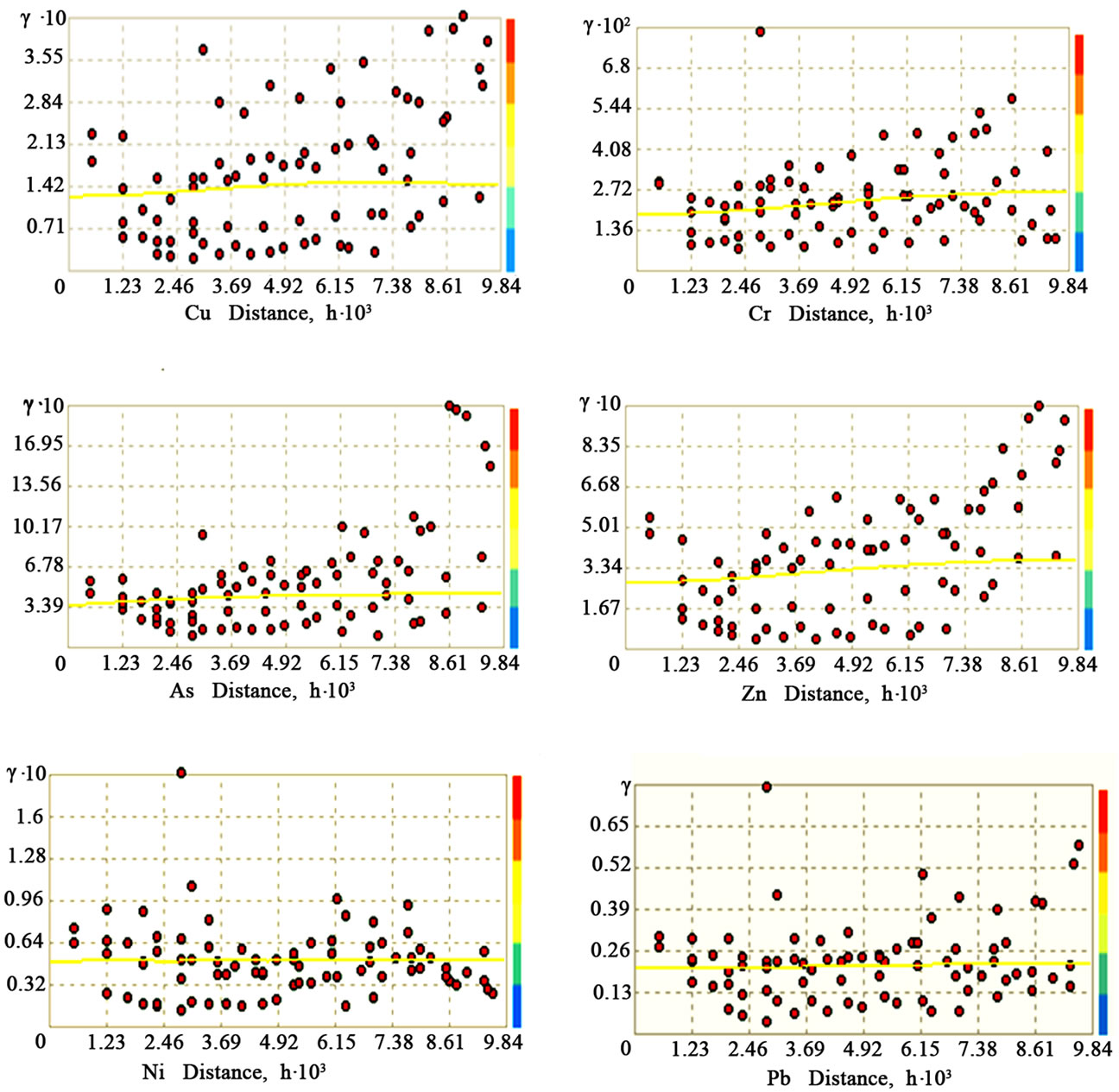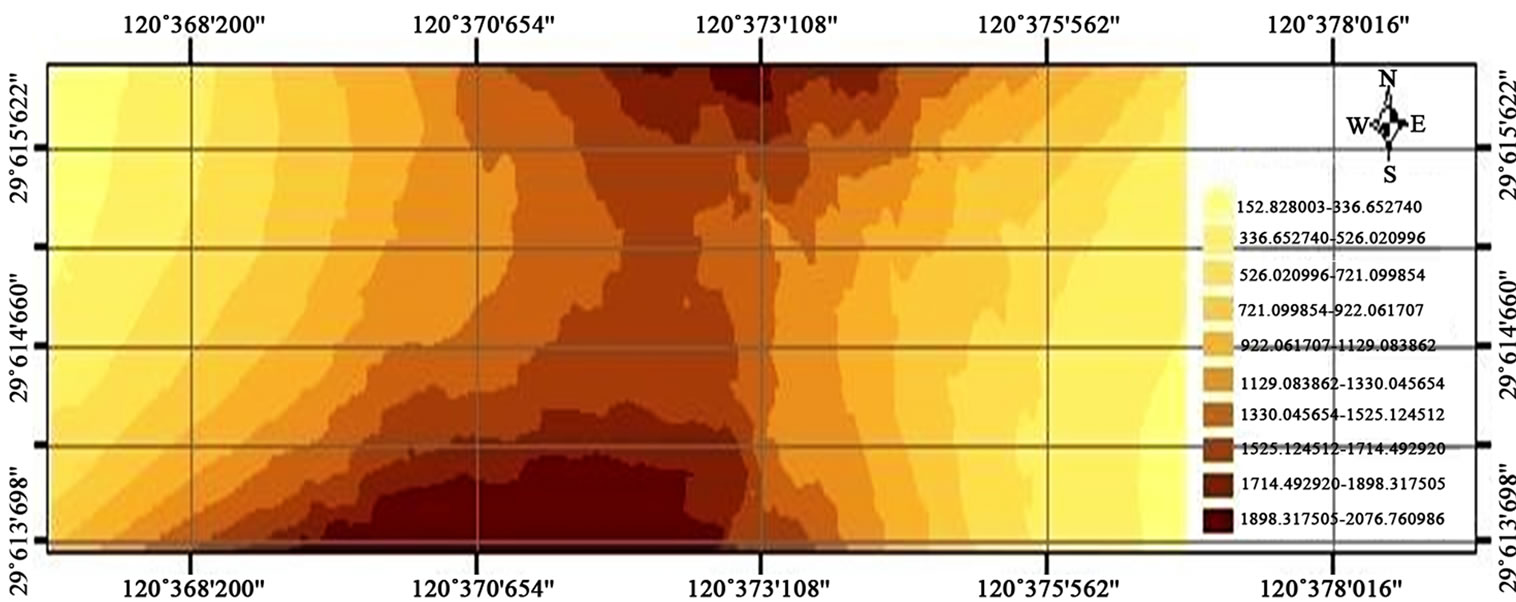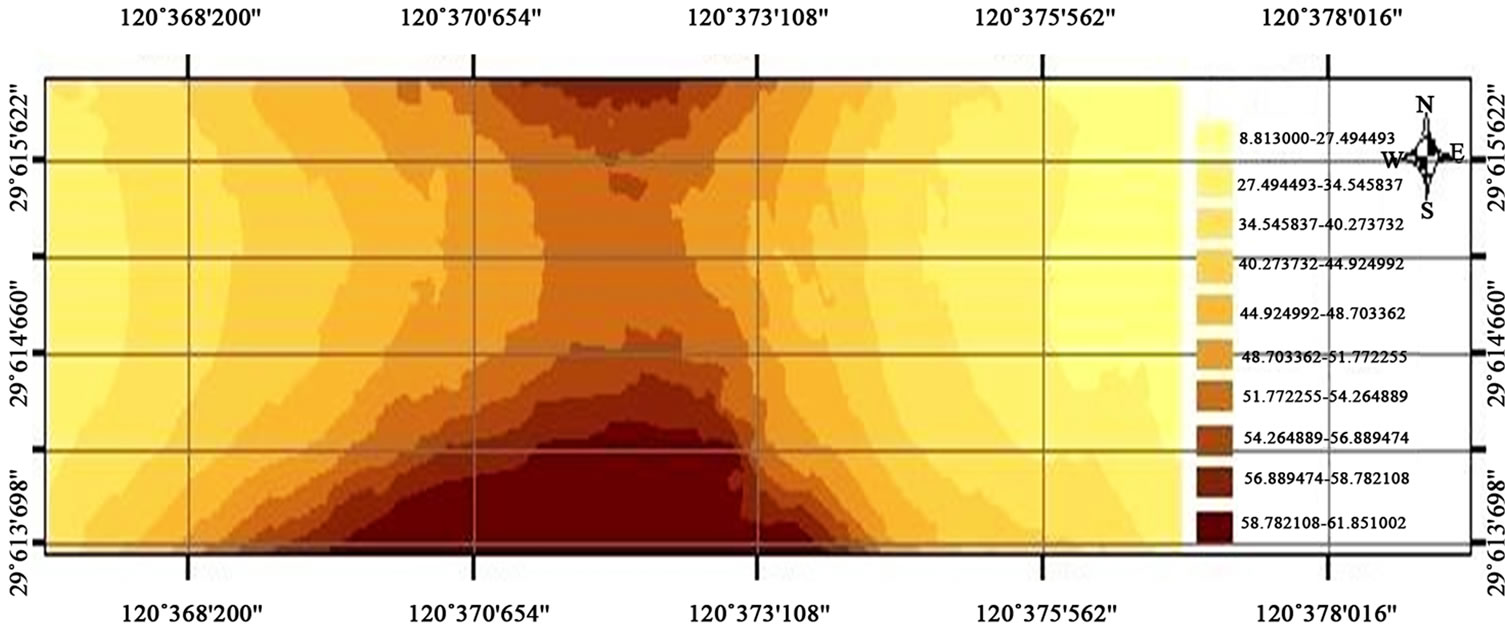Journal of Geographic Information System
Vol.4 No.1(2012), Article ID:17065,9 pages DOI:10.4236/jgis.2012.41007
Heavy Metals’ Spatial Distribution Characteristics in a Copper Mining Area of Zhejiang Province*
1Department of Resource, Environment and Urban and Rural Planning, Nanjing Agricultural University, Nanjing, China
2Department of Geographic Science, Zhejiang Normal University, Jinhua, China
Email: sh@njau.edu.cn
Received July 11, 2011; revised September 3, 2011; accepted September 23, 2011
Keywords: Copper Mining Area; Heavy Metals; Spatial Characteristics; GIS
ABSTRACT
The spatial distribution characteristics of six heavy metals and metalloid in soil of Zhuji Lipu copper mining area, Zhejiang Province, was studied by using geostatistics approaches combined with GIS. These elements included Pb, As, Cr, Cu, Zn and Ni. The statistical analyses showed that concentrations of these elements were lognormal distribution. Concentrations of Pb, As, Cu, Zn and Ni were strongly correlated with each other indicating that these elements in soils may be from the same pollution source. However, accumulation of Cr was unique with its geometric mean being close to that in the control soil. This indicates that Cr content was mainly influenced by soil factors. The Kriging method was applied to estimate the unobserved points. The Kriging interpolation maps reflected significant spatial distribution of these elements as influenced by both pollution and geological factors. The present study indicated that GIS based geostatistics method could accurately analyze the spatial variation of heavy metals and metalloid in the mining area. Overall, higher concentrations of heavy metals and metalloid were found in the center of both the north and south sides. The content of copper in the south was significantly higher than that in the north due to paddy field land uses. In addition, the terrain of four terraces tilted to the center and the broad irrigation accident occurred in the 4th trench in the south of sampling area were also contributed to the higher concentrations of these elements.
1. Introduction
Arable land pollution was becoming more serious in China and the world [1]. Mining and smeltering activities not only generated heavy metal pollution but also resulted in determination of soil quality and destruction of the ecological function of the system [2]. Currently in southern region of China, rapid development in mining industry has produced significant environmental problems including mine soil, water, and air pollution [3-6], which seriously affected food security and health of human and animal. Due to their long-term duration, heavy metal polluted soil is difficult to be remediated [7]. Therefore, remediation of heavy metal polluted soils has become a hot issue and understanding of the spatial distribution and variation of heavy metal pollution is an important prerequisite.
The objectives of this study were to investigate the spatial distribution and variation of heavy metals and metalloid in soils of Hang Pu copper plants of Zhuji City, Zhejiang Province of China.
2. A study Area and Research Programs
2.1. The Study Area
Zhejiang North-central Pu mine is located in Zhuji City, Zhejiang Province, 29˚43'23"N, 119˚59'09"E with a total area of the mining area 0.8 km 2. Hilly terrain within the mining area was a major landscape. Mining land is in the subtropical monsoon climate with annual average temperature of 16.2˚C and ≥10˚C annual accumulated temperature 4924˚C - 5233˚C. Annual rainfall is 1335.9 mm and annual average evaporation is 1260.7 mm with annual average relative humidity of 75.1%. Soil type is mainly yellow red soil with red sandstone-shale development. Sampling areas are located north of the mining area.
2.2. Soil Sampling Plan
Since the mine area had relatively simple topography, the total 48 samples with a space between adjacent points of 10 meter were planned in order to ensure a representative sampling. In the north side of one major irrigation trench, all these sampling were carefully distributed according to the land-use types and topographic characteristics (face, direction and length of ladder status) (Figure 1).
Mining water overflowing has occurred in the south east side of the 4th irrigation tunnels. Sampling areas was located about 300 meters south side and irrigation canal was along the general direction of flowing through the sampling areas from south to north central region.
2.3. Soil Sample Collection and Analyses
According to “soil environmental quality monitoring technical specifications (NY/T395-2000)”, soils were collected and prepared. Surface soil (0 cm - 20 cm) was sampled from each point. Soils were then air-dried and ground through 2 mm sieve for analyses. Soils were analyzed for total lead, arsenic, chromium, copper, zinc, nickel, pH and etc [8].
Lead, arsenic, chromium, copper, zinc, nickel were determined with British X-ray fluorescence wavelength dispersive spectrometer (Model AFS-820, PANalytical Axios production company).
2.4. Spatial Variability Analysis Method
Geographic information system (GIS) is fit for acquisition and processing of the environmental information and based on geographic location and the spatial analysis techniques, which can make a quantitative evaluation of regional environment. We can visual display changes in the regional distribution of pollution by taking advantage of GIS technology with visualization of the results of the evaluation. At present, geographic information system (GIS) has been widely applied to the research of regional environmental pollution as an important spatial analysis technology; it provides effective means for researching the spatial variability of pollutants.
Therefore, the paper chooses this method to research the spatial distribution characteristics of heavy metals and show the importance of the impact of heavy metals on the ecological environment.
In this paper, geostatistical spatial analyses were used to generally semi-variance map and describe spatial variability [9]. As a best spatial interpolation method, it has been widely applied to a regionalized variable characterization in soil science, environmental science and ecology and other fields [10]. ArcGIS9.1 was used for this geostatistical analysis, including the semi-variogram (semivariogram) of the calculation and fitting comparison, Kriging spatial interpolation and simulation error analysis.
Semi-variance function is also often referred to as variation function, which is studied in geostatistics of soil variability [11]. Located in the one-dimensional (two-dimensional or three-dimensional) space in different locations x1, x2, xn on a certain soil characteristics of the observed value of Z(x1), Z(x2),
xn on a certain soil characteristics of the observed value of Z(x1), Z(x2), Z(xn), Semi-variance [γ(h)] can reflect the spatial dependence of regionalized variables, the calculation can be estimated under:
Z(xn), Semi-variance [γ(h)] can reflect the spatial dependence of regionalized variables, the calculation can be estimated under:

where N (h) is used for spacing the number of all pairs of observation points. With h as the abscissa, γ(h) was for the vertical coordinate mapping, that is, semi-variance diagram. Spatial local interpolation (Kriging method) is based on variation of a function and its structural analysis in a limited region of the regionalized variable values for the best linear unbiased estimation method, namely, (is a weighting factor, Z(x) is the sample value, Z is the estimated value):

3. Results and Analysis
3.1. Statistical Analysis of Concentrations of Soil Heavy Metals and Metalloid
Concentrations of six heavy metals were summarized in Table 1. The results showed that the highest variation

Figure 1. Distribution of sampling points.

Table 1. Descriptive statistics of soil heavy metals and metalloid contents (mg/kg).
was found for concentrations of As, Cu, Zn, and Pb. The sources of these elements were contamination from mining activities over the years, especially through acid mine waste water. According to field surveys in 1967, the study area received acid mine waste water outside the Bay. In addition, a heavy application of chemical fertilizers and pesticides may also be important pollution sources for these elements. The major chemical fertilizer was superphosphate, potassium chloride, and urea. Frequently phosphate fertilizers contained some of these elements. Among all these elements, Cr had the least variation as well as Ni, indicating fewer impacts of anthropogenic sources on these two elements Cr and Ni.
According to the soil environmental quality standard of China (GB15618-1995), soils in the studied area (pH < 6.5) exceeded 100% of copper and zinc, lead standards, 91.67% of arsenic and 79.17% of nickel. For the studied area, soil copper, zinc, lead and arsenic contents have reached critical levels of pollution. But nickel pollution was relatively slight with an average of 45.7 mg/kg (Ni Class II standard is 40 mg/kg), while chromium has not yet to reach pollution levels. Therefore, the study area was in general characterized by combined pollution of main Cu, Zn, Pb and As.
In addition, the skewness and kurtosis analyses indicate that arsenic, chromium, copper, zinc, nickel, and lead had a negative bias, and the addition to both Cr spikes outside the state. The frequency distribution histogram (Histogram) showed that six heavy metals and metalloid in soils studied were characterized by normal distribution.
3.2. The Correlation between Heavy Metals and Metalloid in Soils
Table 2 showed that in soils of the studied area, a strong cross correlation occurred among these heavy metals and metalloid, especially between As-Cu, As-Zn, As-Ni, AsPb, Cu-Zn, Cu-Ni, Cu-Pb, Zn-Ni, Zn-Pb, Ni-Pb. This indicates that all these elements may have a same source mainly from anthropogenic mining relevant activities. However, correlation between Cr and As or Cr, Cu, Zn, Ni, and Pb were low. Therefore, As has the homology with Cu, Zn, Ni and Pb.
Affected by mining pollution processes, the content of As changed simultaneously with other heavy metals, while Cr was not significant, the elements of mining pollution and the distribution were further demonstrated.
3.3. Spatial Variation Analysis of Heavy Metal in the Soil under the Conditions of the Isotropic
Due to the presence of specific value of the variable, which may cause interruption of a continuous surface, experimental semi-variogram will distort or even obscure the inherent spatial structure of the variable characteristics [12]. In this paper we identified the specific valuedomain method [13], that is, the sample average plus or minus three times the standard deviations, in this interval (±3 s) other than the data were as specific values, and then the normal maximum and minimum values were used instead of specific values. Subsequent calculations were based on the field data after treatment.
A study of six soil heavy metals and metalloid in the isotropic condition was shown in Figure 2. According to the actual variation of the function, semi-variance for the vertical axis and the sampling distance of abscissa displayed the semi-variance fitting curve drawn map. Each element of the semi-variogram curve has a significant continuous increase in range. When the semi-variance with the increasing of separation distance has reached a certain scale (variable range), the Semi-variance curve becomes flat. The correlation between samples in more than this distance was no longer relevant after, and it appeared as when h > a time, γ(h) was at a value of up and down swing, so there is spatial variability of the structure. This change pattern can be used with a threshold value (Sill) models fitted to choose the best theoretical model variogram. Using ArcInfo in the analysis of the statistical analysis module, a variety of model interpolation error may be produced. If the forecast errors are unbiased, then the mean prediction error should be close to zero.

Table 2. The correlation coefficients of concentrations of soil heavy metals and metalloid.

Figure 2. The corresponding graph of semivariograms of soil heavy metals.
It is necessary to fit different methods and parameters repeatedly for determining the theoretical model, in order to obtain the theoretical variation function for simulating that distance has impacted on data point. So, theoretical variation curves should be the most approximation with experimental variation of the function, which was generated by the chosen method, especially with small steps. It is required to determine the fitting degree between the theoretical variation function and the experimental variation function for inspecting the validity of the model.
Through several times of fitting, Table 3 shows the best fitting theoretical model and its parameters for the six heavy metals and metalloid in the semi-variance selected. The results show that, for Cr and Zn the Gaussian model may be theoretical model of the semi-variance; the J-Bessel may be for Ni; the Hole Effect model for Cu and Pb; and the Exponential model for As.
The ratios of soil nugget values to the value of base stations for these elements were as follows: Lead > Copper > Arsenic > Zinc > Nickel > Chromium. Lead, copper, and arsenic had ratios of element nugget value to that of base stations, of 92.6014%, 86.6664%, 76.0163%, respectively. The ratios of soil nugget values to those of base stations for other three heavy metals were 25% - 75%. Spacial correlations were controlled by the structural factors and random factors. Structural factors included such as parent material, soil type, climate, and soil-forming factors, while random factors were farming, management practices, cropping systems, land use patterns, pollution and other human activities.
The optimized model should meet the following criteria: the minimized (close to 0) Standard Mean (Mean Standardized), the minimum root mean square prediction error (Root-Mean-Square), the minimized (close to 0) average standard error (Average Standardized Errors), closest root mean square prediction Error (Root-Mean-Square), closest (to 1) standard root mean square prediction error (Root-Mean-Square-Standardized) [14] (Table 4).
3.4. The Simulated Values and Measured Values of the Cross-Validation
Cross-validation was conducted in the data of all samples. Each time removing one of the points, with the remaining points, the value of the predicted value of the point, was compared to the actual value and the predictive value of the difference between the validations of spaceinterpolation was used to analyze the degree of accuracy, thus the best Kriging analysis was selected. In theory, the best prediction is equal to the actual measured values and the slope between them should be a linear related. As the spatial interpolation in the process of smoothing (smoothing) effects, the linear slope between the measured values and predicted values is usually less than 1. For example, the predicted values of soil Pb and the measured values of the relevant equation are:
Y = 0.71X + 342.779 The correlation between measured values and the predictive values of these six heavy metals and metalloid was at significant level (Table 5).

Table 3. Theoretical semivariogram models of soil heavy metals and metalloid and their corresponding parameters.

Table 4. The interpolation errors of semivariogram corresponding models.

Table 5. The correlation coefficients between measured values and predictive values.
3.5. The Spatial Distribution of Soil Heavy Metals and Their Patterns
According to the principles of Kriging interpolation and semi-variogram fitting parameters, Geostatistical Analyst in ArcMap software was applied for analyzing module spatial variability of interpolation. Therefore spatial distribution of trends of six heavy metals and metalloid and the distribution of these elements classification map were produced (Figure 3). Kriging interpolation was affected by variation function model simulation accuracy, the distribution of samples, the selection of the number of adjacent samples and many other factors. Interpolation accuracy may be reflected through the interpolation error. The smaller the variance, i.e., the standard root mean square prediction error close to 1, the more accurate Kriging interpolation [15].
The Kriging interpolation maps for soil copper, zinclead, arsenic, and nickel content were shown in Figures 3-8. The overall distribution trends show a north-south direction with higher values in the center. With decreasing from the center of north-south direction the higher values were found in the south than in the north of Grand.
According to the Chinese 1995 soil environmental quality standards, the maximum allowable concentration of pollutants were summarized as follows (Figures 3-8). In all regions copper and zinc contents were more than Class II standard criteria for acidic soils; in northwest, east and south-east part of the region, the lead level was between Class I and Class II threshold criteria, and the rest of area, Pb was beyond the critical value of the standard Class II for acidic soil. In addition, the north-west and eastern parts of the region had arsenic content around the threshold criteria of Class I and the rest areas had As

Figure 3. The interpolation map of Cu.

Figure 4. The interpolation map of Zn. ![]()

Figure 5. The interpolation map of Pb.

Figure 6. The interpolation map of As.

Figure 7. The interpolation map of Ni.

Figure 8. The interpolation map of Cr.
beyond the Class II criteria. Northwest, northeast, east and south-east areas had nickel content between the standard critical values of Class I and II for acidic soil with the rest areas exceeding threshold of Class I and Class II.
The overall distribution of chromium in soil showed the trends with highest values in the north, followed by the south and decreasing in the direction of the east-west. In the study area, north and south appeared to have relatively high values of chromium. East, south-east and north-east regions with mainly mountainous areas had relatively low chromium content. According to the 1995 soil environmental quality standards, the east, southeast and northeast regions had chromium contents below the Class I critical value, while the rest of regions had Cr contents between Class I and Class II criteria for the acidic soil. All soils had Cr concentrations below the standard threshold for acidic soil.
4. Conclusions
Heavy metals and metalloid (arsenic, copper, zinc, nickel, and lead) have been significantly accumulated in soils around the 4th trench. Strong correlation among these elements may indicate all these elements came from the same pollution sources [16]. The contamination sources may be from both natural, i.e., geochemical sources, or anthropogenic source, i.e., human activities, or combined pollution sources. The present study showed strong correlation between As-Cu, As-Zn, As-Ni, As-Pb, Cu-Zn, Cu-Ni, Cu-Pb, Zn-Ni, Zn-Pb, Ni-Pb, indicating the highly possibility of the same sources of these elements. However, correlation between Cr and As, or Cr, Cu, Zn, Ni, and Pb was low, indicating that Cr was less accumulate in the region as well as less possibility of exogenous anthrogenic source. On the other hand, As, Cu, Zn, Ni, Pb were the elements most associated with pollution source.
Ratios of nugget values of heavy metals in soils to base stations were in the order: lead > copper > arsenic > zinc > nickel > chromium. Lead, copper, arsenic had the ratios of nugget values to base stations of 92.6%, 86.6%, and 76.0%, respectively. In accordance with classification criteria of spatial correlation of regionalized variables [17], these three elements were specially weakly correlated, because human activity weakened their spatial correlation. The rest heavy metals had 25% - 75% ratios of nugget values to base stations, indicating their moderate spatial correlation. Chromium had relatively low ratio of nugget values to base stations and the chromium content in soils of studied area was close to the geometric mean, implying that chromium was mainly affected by soil formation factors.
Copper, zinc, lead, arsenic, and nickel had the similar spatial distribution in the studied areas. In general, their distribution showed the high accumulation in the center of the regions with decreasing concentrations form the center towards both south and north direction. In the study area, higher concentrations of Cu were found in the center region in the direction of south-north, and concentration of Cu in the south side was higher than that in the north side. This is mainly due to land use patterns and topography of the landscape in the region. Paddy fields were main land use in the south side where irrigation water was through the 4th trench. However, in the north side, vegetable and wasteland were the major land use where runoff flew from the mining tailing area. This may contribute to the high concentrations in the soils of the north side. In addition, the terrain of four terraces tilted to the center and the broad irrigation accident occurred in the 4th trench in the south of sampling area were also contributed to the higher concentration of these elements.
REFERENCES
- J. M. Shu, J. J. Wang and X. C. Liu, “Ecological Restoration of Mining Wasted Lands,” China Population, Resource and Environment, Vol. 8, No. 3, 1998, pp. 72-75.
- M. K. Zhang and Z. X. Ke, “Copper and Zinc Enrichment in Different Size Fraction of Organic Matter from Polluted Soils,” Pedosphere, Vol. 14, No. 1, 2004, pp. 27-36.
- H. M. Chen, “Heavy Metals Pollution in Soil-Plant System,” Science Press, Beijing, 1996, pp. 1-14.
- Y. J. He and L. X. Zhu, “China’s Mineral Resources,” Shanghai Education Press, Shanghai, 1987, pp. 219-220.
- L. Gao, W. M. Zhang and X. H. Yang, “Studies on the Issues of Modern Ecology: The Rectification of Nonferrous Metals Industrial Environment and the Reclamation of Mine Land,” China Science and Technology Press, Beijing, 1996, pp. 572-582.
- C. Tu, C. R. Zheng and H. M. Chen, “The Current Status of Soil-Plant System in Copper Mine Tailings,” Acta Pedologica Sinica, Vol. 37, No. 2, 2000, pp. 135-143.
- Z. M. Gao, “Ecological Research on the Pollution of SoilPlant System,” China Science and Technology Press, Beijing, 1986.
- Institute of Soil Science, “Analysis of Soil Physical and Chemical Properties,” Shanghai Scientific and Technical Publishers, Shanghai, 1978.
- T. M. Burgess and R. Webster, “Optimal Interpolation and Isarithmic Mapping of Soil Properties. I. The SemiVariogram and Punctual Kriging,” Journal of Soil Science, Vol. 31, No. 2, 1980, pp. 315-331. doi:10.1111/j.1365-2389.1980.tb02084.x
- P. Goovaerts “Geostatistics in Soil Science: State-of-theArt and Perspectives,” Geodema, Vol. 89, No. 1-2, 1999, pp. 1-45. doi:10.1016/S0016-7061(98)00078-0
- H. C. Guo, “Land Restoration in China,” Acta Ecologica Sinica, Vol. 10, No. 1, 1990, pp. 24-26.
- C. S. Zhang, S. Zhang and J. B. He, “Spatial Distribution Characteristics of Heavy Metals in the Sediments of Yangtze River System-Geostatistics Method,” Acta Geographica Sinica, Vol. 52, No. 2, 1997, pp.185-192.
- S. Q. Wang, S. L. Zhu and C. H. Zhou, “Characteristics of Spatial Variability of Soil Thickness in China,” Geographical Research, Vol. 20, No. 2, 2001, pp. 161-169.
- H. B. Li, Z. H. Lin and S. X. Liu, “Application of Kriging Technique in Estimating Soil Moisture in China,” Geographical Research, Vol. 20, No. 4, 2001, pp. 446-452.
- G. A. Tang and X. Yang, “ArcGIS Spatial Analysis Experiment Guide,” Science Press, Beijing, 2006, p. 405.
- F. A. Galley and O. L. Lioyd, “Grass and Surface Soils as Monitors of Atmospheric Metal Pollution in Central Scotland,” Water, Air and Soil Pollution, Vol. 24, 1985, pp. 1-18.
- C. A. Cambardella, T. B. Moorman, J. M. Novak, et al., “Field-Scale Variability of Soil Properties in Central Iowa Soils,” Soil Science Society of America Journal, Vol. 58, No. 5, 1994, pp. 1501-1511. doi:10.2136/sssaj1994.03615995005800050033x
NOTES
*The manuscript was sponsored by the humanities and social scientific research project in 2010, under Grant No. 10YJA630138, and a Project Funded by the Priority Academic Program Development of Jiangsu Higher Education Institutions (PAPD).

